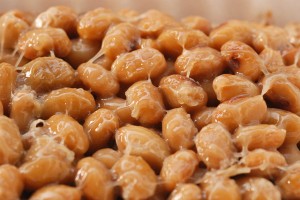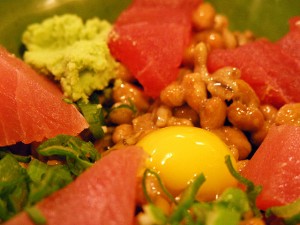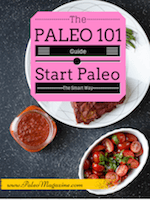Is Natto Paleo?
 Natto may not be a food with which you are intimately familiar, unless you’re really into Japanese cuisine. In fact, you may not even know what natto is.
Natto may not be a food with which you are intimately familiar, unless you’re really into Japanese cuisine. In fact, you may not even know what natto is.
What is Natto?
Simply, natto is a fermented form of soybean.
It’s often eaten for breakfast with a bit of rice but can also be found in sushi and other Japanese foods.
Natto has a very pungent smell that deters some people from eating it. Moreover, the fermentation process makes the soy beans form stringy strands.
Traditionally natto was made by fermenting the soybeans in straw, but nowadays, fermentation is done in much more sterile conditions, for better or worse.
Potential Concerns
To begin with, natto is made from a legume, which should immediately relegate to the non-Paleo realm. (Read here for more about why legumes aren’t Paleo.)
And not only is natto made from a legume, it’s made from soybeans, which are very high in phytoestrogens that can disrupt your body’s hormones.
Generally, you should probably try to avoid soybeans as much as possible – especially in processed forms like tofu and soymilk.
Why Natto Might be Very Good for You
 Most of the problems with legumes are made worse by the fact that legumes are generally eaten as staples. In other words, they’re eaten constantly, rather than just occasionally.
Most of the problems with legumes are made worse by the fact that legumes are generally eaten as staples. In other words, they’re eaten constantly, rather than just occasionally.
However, unless you live in certain parts of Japan, natto is not likely to be something that you eat on an ongoing basis.
In addition, natto has a huge advantage: it’s fermented.
As you probably know, fermented foods are generally pretty healthy foods. The fermentation process breaks down a lot of toxins (including phytic acid), and fermented foods often serve as beneficial prebiotics.
In the case of natto, this is certainly true. It’s a great prebiotic, but even more importantly, natto is exceptionally high in Vitamin K2. If you’re not familiar with vitamin K2, it’s partially because it isn’t found in many foods at all. Natto is certainly the best source.
Mark has the most succinct analysis here of why K2 is such an important vitamin, but general research shows that it prevents osteoporosis and reverses arterial calcification. In other words, it’s a pretty awesome vitamin.
Is Natto Paleo?
Yes
It’s arguable whether it was eaten a million years ago, but it really doesn’t matter. Natto has a lot going for it nutritionally, and has relatively few toxins, so long as you’re not eating it on a daily basis.
Huge Caveat
Almost 100% of the Natto that we’ve found in supermarkets in the United States have quite a few added ingredients that you should avoid.
Most natto that we see contains added MSG and also a huge amount of sugar, often in the form of high-fructose corn syrup. Those tend to be the worst additives, but we’ve seen countless others.
Obviously, even to the degree that we consider natto to be Paleo, you should be very careful about what’s in the natto that you purchase at a supermarket.
Let me know what you think! Do you eat Natto? Can you stand the smell? Where do you get it?
Images (in order): jasja dekker and juicyrai.

